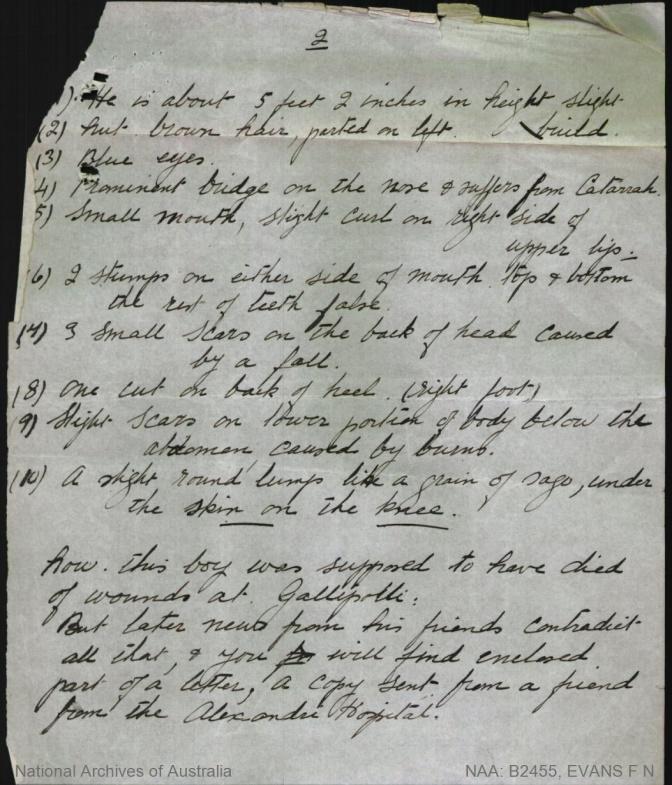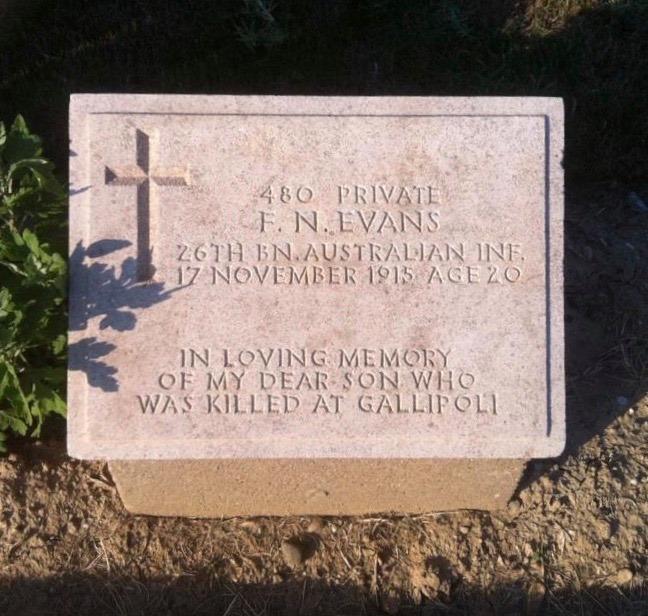“I know it is Frank”
Frank Norman Evans, the son of Sarah and Edward Evans from Charters Towers, Queensland, was 19 years old when he enlisted in the Australian Imperial Force on 19 April 1915. Serving with the 26th Australian Infantry Battalion, he arrived on Gallipoli in September 1915. In early November the 26th moved to new positions at Russell’s Top, a ridge area between the Sphinx and the Nek. Shortly after on 16 November, Turkish bombing at Russell’s Top devastated the area, collapsing tunnels and knocking down parapets. Four men were wounded in the attack, including Frank. Hit by shrapnel from a bursting shell, Frank was taken to the 5th Field Ambulance for treatment. The following day, he died from his wounds. Frank was laid to rest in Shrapnel Valley Cemetery in a burial service led by Chaplain H. S. Reid.
Gallipoli trench map. Russell's Ridge where Frank was injured, and Shrapnel Valley, where he was buried, can both be seen on the map.
As Frank’s next of kin, Sarah was officially notified of his death. A devastating loss under any circumstances, losing a child serving overseas in the First World War meant having to grieve without the usual mourning rituals of a funeral or a gravesite to visit. The following year, Sarah received information that she could not ignore and that gave her hope that her son might in fact have survived.
On 26 January 1916, Sarah received a letter from a wounded soldier in Alexandria.
I have a piece of news for you. There is a young fellow lying in the next bed to me, named F. N. Evans. He was brought in the middle of November with his left arm off. His hair has gone white on both sides from shock, and his memory has gone. He is a great favorite with all here. The other night he sang the first verse of "Lead Kindly Light," then his voice failed. He only spoke once since he was brought in; he said "Townsville” once. When I move about he pats the stool for me to sit beside him. He likes me to smooth his hair. I might have to go to England to get a new leg on in place of mine. I asked the doctor if he could go with me. He said, "Yes, if he is strong enough." He said a shock will give him back his memory. I will take care of him. I know it is Frank, I used to go to the State school with him. Tell Mrs. Evans she is not the only woman I have let know their boys are alive.
(“Is Frank N. Evans Dead?” The Evening Telegraph, 7 April 1921, p. 2)
Not long after receiving the letter, Sarah received news from G. Mann, a soldier from Charters Towers, stating that Frank had been taken aboard the hospital ship when he was wounded. These reports contradicted the official report that Frank had died with the 5th Field Ambulance on the Gallipoli peninsula. For Sarah, these letters cast doubt on the official version of events and prompted her to search through newspapers, reports and magazines to find more conclusive evidence of Frank’s survival.
In May 1917 Sarah believed she had found just that when she came across a newspaper photograph of a group of wounded Australian soldiers celebrating Christmas 1916 in an English hospital. The photograph had had been published in a number of newspapers. She believed Frank was one of the soldiers shown.
To Sarah this photograph, taken a year after Frank’s supposed death, was compelling evidence that her son had not perished on Gallipoli. Her hopes were also supported by the reference in the wounded soldier’s letter about Frank’s memory loss and his possible transfer to England.

The photograph cited by Sarah Evans in her letter to the YMCA as proof her son Frank was alive. She believed Frank to be the soldier sitting in the wheelchair in front of the piano. Source: Sydney Mail, Wednesday 28 February 1917, p. 16 “How ANZACS in London spent Christmas”.
Feeling confident in her discovery, Sarah contacted the Secretary of the Young Men’s Christian Association (YMCA):
How this boy was supposed to have died of wounds at Gallipoli, but later news from his friends contradict all that … Once again trusting you will do your best for me, by bringing or sending him home to me, no matter what he is suffering from.
(B2455, EVANS F N, National Archives of Australia)
Desperate for Frank to come home, Sarah included a list of his identifying features, including his eye colour, scars and details of his false teeth.

Sarah Evans' letter listing her son’s 10 identifying features. Note that she describes his eyes as blue, when Frank described them as brown in his enlistment papers. B2455, EVANS F N
While Sarah believed she had seen Frank in the photograph, the Officer in Charge at Base Records highlighted some key differences between the photograph and the wounded soldier’s description of Frank:
It will be noted he states the soldier who was lying next to him had his left arm off and hair had gone white on both sides; an inspection of the photograph discloses neither of these things, the soldier marked with a cross having both his arms and his hair being of natural colour.
(B2455, EVANS F N, National Archives of Australia)
The same officer also noted that:
It seems unreasonable to believe that Private Evans could have been moved from Hospital to Hospital, without some entry having been shown in the various Admission reports.
(B2455, EVANS F N, National Archives of Australia)
We will never know if Sarah ever fully accepted the death of her son, or if doubts persisted for the rest of her life. In 1920 Sarah provided Base Records with an inscription for his headstone, which suggests that by this time she may have accepted his death.

F.N. Evans' grave at Shrapnel Valley, Gallipoli. Photo: Chelsea Heaney, 2015
Doubts over Frank’s death were renewed one more time in April 1921 when The Evening Telegraph, a Charters Towers newspaper, published an article titled “IS FRANK N. EVANS DEAD?” The article mentioned the letters Sarah had received in 1916, and stated that “an unsigned cablegram has now been received from Berkeley, California stating ‘Frank in Manilla’”, and that the local Returned Sailors and Soldiers Imperial League Australia (now the Returned and Services League) were investigating. The outcome of their investigation is unknown.
Sarah passed away at her home in 1947. She was 84 years old.
On Sunday 29 November 2020 at 10.27 pm Frank was commemorated by the projection of his name onto the exterior of the Hall of Memory.
Sources:
“Holmes Family Tree”, Ancestry.com
[Unit manuscript histories:] 26th Australian Infantry Battalion: Short history by Maj P V O Fleming, Australian War Memorial, AWM224 MSS24
[Australian Imperial Force unit war diaries] 26th Infantry Battalion, Australian War Memorial, AWM4 23/43
Evans Frank Norman : SERN 480 : POB Charters Towers QLD : POE At sea : NOK M Evans Sarah Louisa, National Archives of Australia, B2455, EVANS F N
“How ANZACS in London spent Christmas”, Sydney Mail, 28 February 1917, p. 16. Retrieved from http://nla.gov.au/nla.news-page16902804
“Is Frank N. Evans Dead?” The Evening Telegraph, 7 April 1921, p. 2., http://nla.gov.au/nla.news-article214982198
“PERSONAL” The Northern Miner, 30 August 1947, p. 2., http://nla.gov.au/nla.news-article81409556

